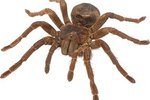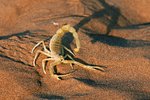In the wild, the Singapore blue tarantula (Lampropelma violaceopes) lives in the moist tropical rainforests of Singapore and Malaysia. This large tarantula grows quickly, reaching an adult leg span of between 5 and 10 inches, the female larger than the male. The adult male is greenish, while the adult female acquires the blue or violet coloration for which the species is named.
Housing
An adult Singapore blue tarantula needs an aquarium of at least 30 square feet. This aggressive species should be kept alone. Because he is an arboreal tarantula, he needs a space that has more height and width than length so he has room to move freely. The spider requires at least 3 inches of soft soil or peat moss covering the floor of his enclosure, and plenty of branches and plants for climbing and nesting. A large, shallow dish provides the tarantula with a fresh supply of water.
Temperature and Humidity
The Singapore blue tarantula has specific temperature and humidity requirements. The spider does best in an enclosure with daytime temperature between 77 and 85 degrees Fahrenheit. At night, the tarantula can tolerate moderately cooler temperatures of 73 to 77 degrees Fahrenheit. Misting the aquarium daily maintains the interior’s humidity at between 60 and 75 percent, mimicking the humidity of the Singapore blue tarantula’s tropical jungle home. The spider does best in an environment within this range but can handle humidity as low as 50 percent or as high as 85 percent.
Diet and Feeding
Like other tarantulas, the Singapore blue tarantula is a carnivorous species. The creature senses prey according to movement, so in captivity will not eat pre-killed food. A captive Singapore blue tarantula eats a variety of insects, including crickets, cockroaches, grasshoppers and moths. He will eat small lizards or pinkie mice. Exercise caution when feeding this tarantula, as the Singapore blue is fast and prone to attempting to escape his enclosure.
Behavior and Temperament
The Singapore blue tarantula is quite aggressive -- not social like some other tarantula species. He does not like to be handled and may attempt to flee if picked up. He can escape if held too loosely; but holding him too tightly risks injury to this delicate spider. The species is nocturnal, spending the day sleeping, either in a nest made in the branches of the habitat or under bark and moss in a corner of the enclosure.
References
Writer Bio
Jennifer Mueller began writing and editing professionally in 1995, when she became sports editor of her university's newspaper while also writing a bi-monthly general interest column for an independent tourist publication. Mueller holds a Bachelor of Arts in political science from the University of North Carolina at Asheville and a Juris Doctor from Indiana University Maurer School of Law.





